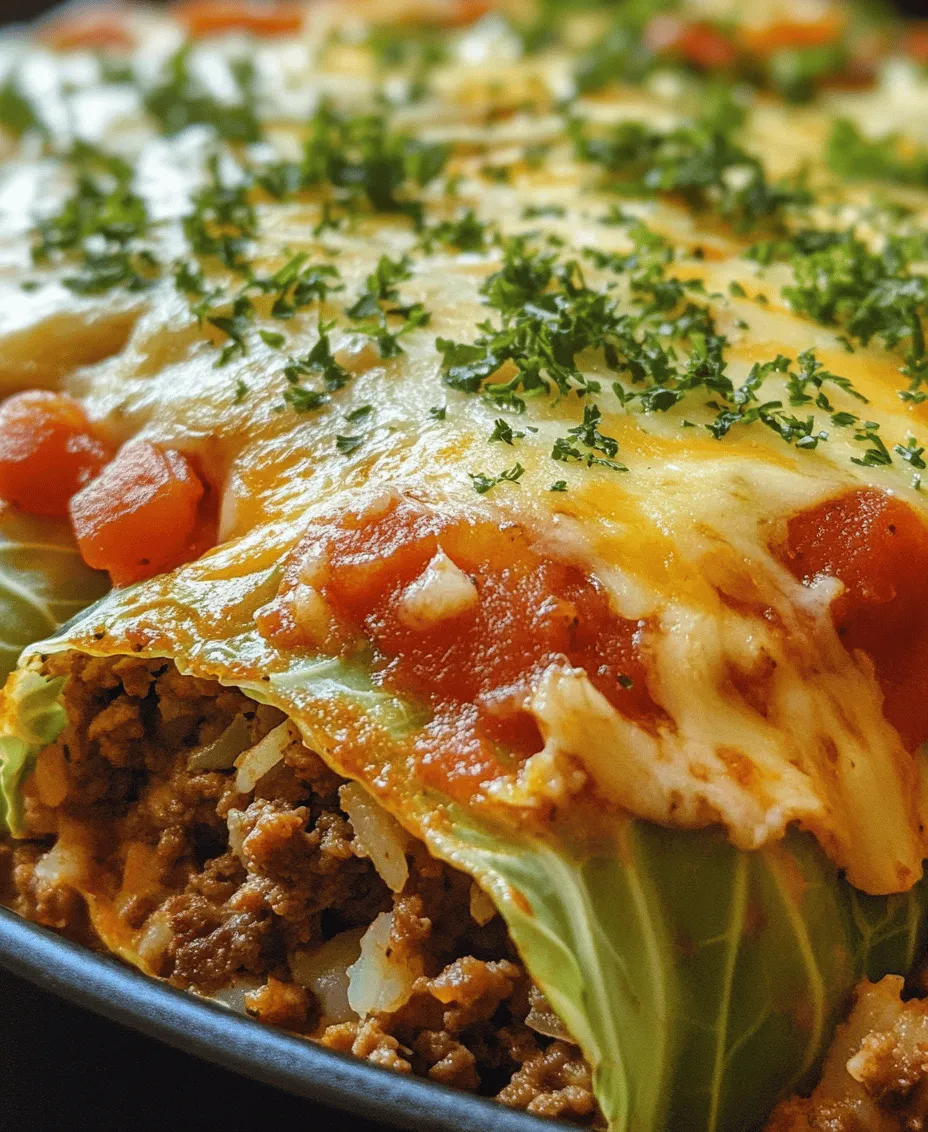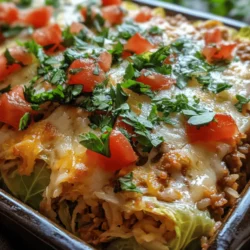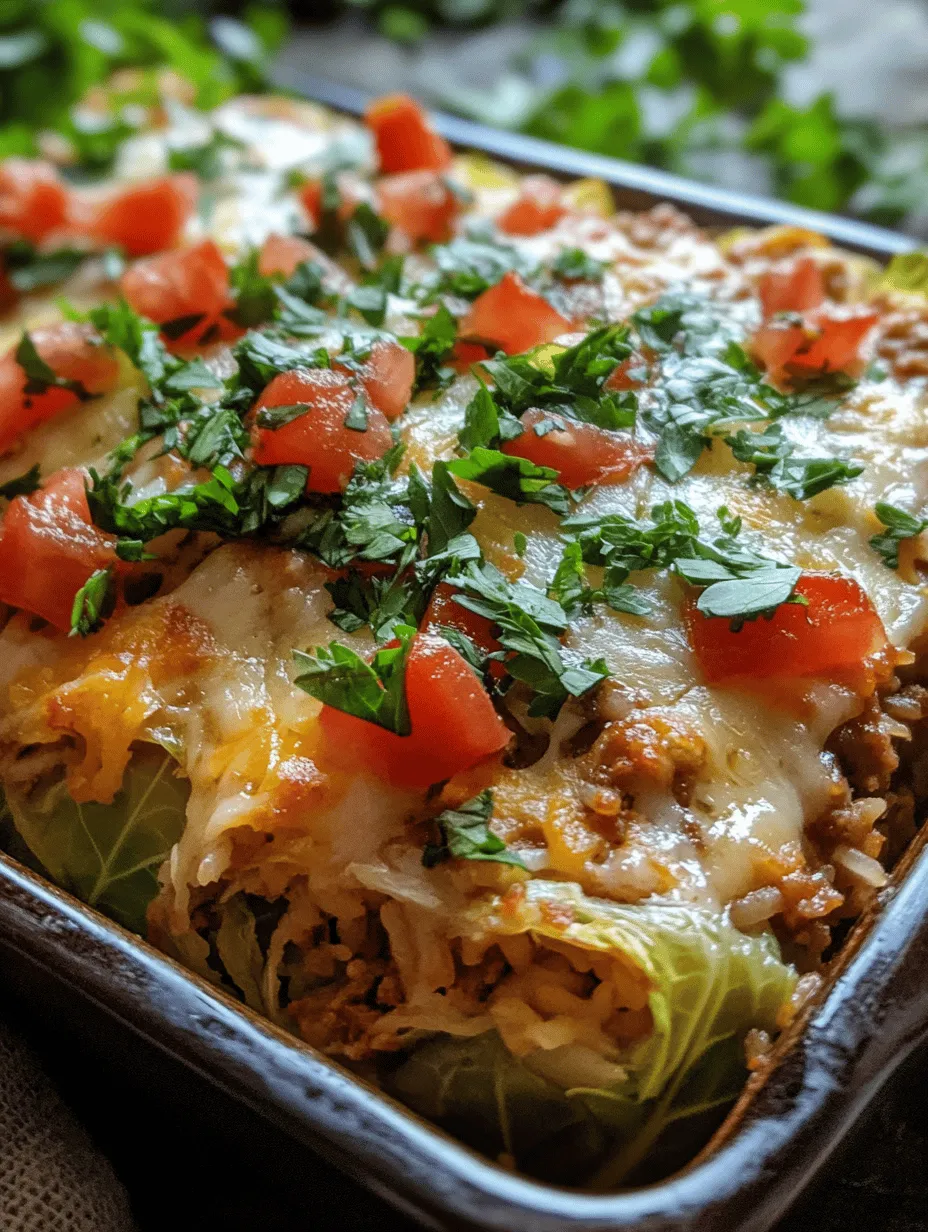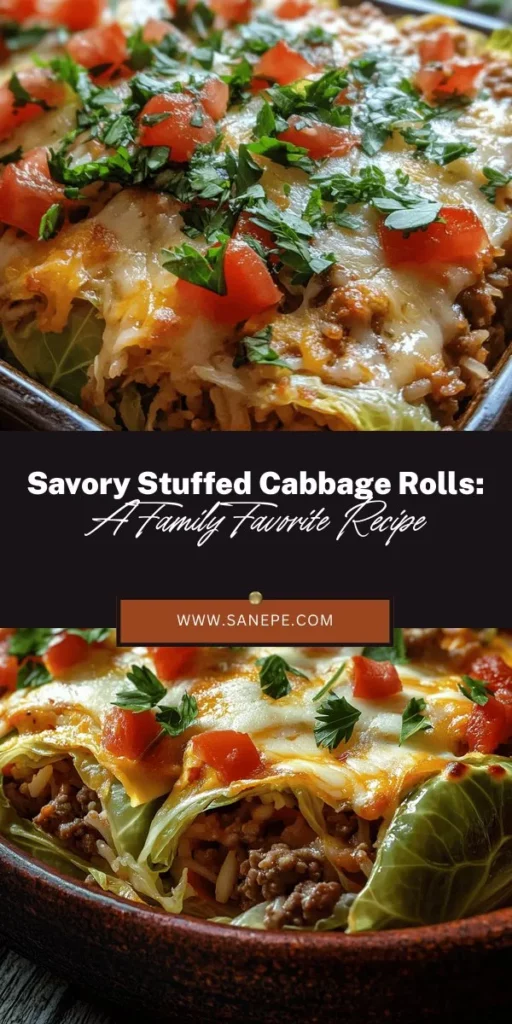Introduction
Savory stuffed cabbage rolls are a beloved dish that transcends cultural boundaries, appearing in various forms in kitchens around the world. From Eastern European homes to Mediterranean tables, these delightful rolls tell a rich history of culinary tradition. Cabbage rolls can be found under many names, including “golabki” in Poland, “dolma” in Turkey, and “sarma” in the Balkans. Each variation showcases the adaptability of this dish, allowing cooks to incorporate local ingredients and flavors, making it a versatile meal option for families and gatherings.
One of the remarkable aspects of cabbage rolls is their adaptability. While traditional recipes often call for ground meats such as beef or pork, there are numerous vegetarian alternatives that make this dish accessible to plant-based eaters. You can easily fill your cabbage rolls with lentils, quinoa, or a mixture of vegetables and grains, providing an equally satisfying meal that is both hearty and wholesome. This versatility not only accommodates different dietary preferences but also encourages creativity in the kitchen.
Beyond their cultural significance and adaptability, cabbage rolls offer numerous health benefits. Cabbage is rich in vitamins C and K, fiber, and antioxidants, making it an excellent choice for those looking to boost their nutrition. When combined with other wholesome ingredients like lean meat, whole grains, and aromatic vegetables, stuffed cabbage rolls become a balanced meal that is both nourishing and satisfying.
In this recipe, we will guide you through the process of making savory stuffed cabbage rolls from scratch, covering everything from selecting the right ingredients to crafting the perfect filling. Whether you’re preparing them for a family dinner or a special occasion, these cabbage rolls are sure to impress everyone at the table.
Understanding the Ingredients
Before diving into the cooking process, it’s essential to understand the key ingredients that will bring our savory stuffed cabbage rolls to life. Each component plays a crucial role in not only the flavor but also the nutritional value of the dish.
Cabbage: Nutritional Benefits and Varieties
Cabbage serves as the foundation for our stuffed rolls, providing a sturdy outer layer that encases the delicious filling. There are two primary varieties of cabbage typically used in this recipe: green cabbage and savoy cabbage.
– Green Cabbage: This is the most common type used for stuffing. It has tightly packed leaves that are crisp and slightly sweet when cooked. Green cabbage is low in calories and high in fiber, making it an excellent choice for those looking to maintain a healthy diet.
– Savoy Cabbage: Savoy cabbage is characterized by its crinkled leaves and more delicate texture. It tends to be milder in flavor compared to green cabbage, which can add a different dimension to your rolls. Nutritionally, savoy cabbage contains similar benefits, being rich in vitamins and minerals.
Choosing the right cabbage can impact the ease of rolling and the final texture of your dish.
Ground Meat Options: Nutritional Profile of Beef vs. Turkey
The filling of your cabbage rolls typically includes ground meat, which adds protein and flavor. Common choices include:
– Ground Beef: A classic option, ground beef is flavorful and provides a rich taste to the rolls. However, it can be higher in saturated fat, so choosing lean ground beef can help reduce the fat content while maintaining flavor.
– Ground Turkey: This is a popular alternative for those looking for a healthier option. Ground turkey is lower in calories and fat than beef, making it a great choice for a lighter filling. It also absorbs the flavors of the seasonings and other ingredients well, ensuring a delicious outcome.
When selecting your meat, consider your dietary preferences and the flavor profile you wish to achieve.
Rice: Comparison Between White and Brown Rice
Rice is another key ingredient that adds substance to the filling. You can choose between white and brown rice based on your preference:
– White Rice: This is the more traditional option, known for its fluffy texture and quick cooking time. However, it is less nutritious than brown rice, containing fewer vitamins and minerals due to the refining process.
– Brown Rice: This whole grain option retains the bran and germ layers, offering more fiber and nutrients. While it takes longer to cook, brown rice provides a nutty flavor and chewy texture that can enhance the overall filling.
Aromatics: Importance of Onion and Garlic in Flavor Development
Aromatic vegetables such as onion and garlic are essential in developing the flavor of the filling. They not only add depth but also contribute to the overall aroma of the dish.
– Onion: Sautéing finely chopped onions until they are translucent and slightly caramelized enhances their natural sweetness, making them a perfect base for the filling.
– Garlic: Freshly minced garlic adds a robust flavor that elevates the dish. It’s important to sauté garlic briefly to avoid bitterness, as it can burn quickly.
Tomatoes: Role of Crushed Tomatoes in the Dish
Crushed tomatoes play a vital role in both the filling and the sauce for the cabbage rolls. They bring moisture and acidity to the dish, balancing the richness of the meat and adding a tangy flavor. Opting for high-quality canned crushed tomatoes can provide a consistent flavor profile throughout the dish.
Seasonings: The Importance of Worcestershire Sauce, Smoked Paprika, Oregano, Salt, and Pepper
The seasoning blend is what truly brings the filling to life. Common seasonings include:
– Worcestershire Sauce: This condiment adds umami and a complex flavor, enhancing the meatiness of the filling.
– Smoked Paprika: This spice introduces a subtle smokiness and depth, complementing the other flavors beautifully.
– Oregano: A classic herb used in many savory dishes, oregano provides an earthy note that ties the filling together.
– Salt and Pepper: Essential for seasoning, these two ingredients should be adjusted according to taste to ensure a well-balanced flavor.
By understanding these ingredients and their roles, you can create a filling that is not only delicious but also nutritionally balanced.
Preparing the Cabbage
The first step in making savory stuffed cabbage rolls is preparing the cabbage itself. This involves blanching the leaves to soften them, making it easier to roll the filling without tearing. Here’s a step-by-step guide to blanching cabbage:
1. Select Your Cabbage: Choose a fresh, firm head of cabbage. Green or savoy cabbage will work well.
2. Remove the Core: Using a sharp knife, carefully cut out the core of the cabbage. This will help the leaves separate more easily.
3. Boil Water: Fill a large pot with water and bring it to a rolling boil. Add a generous pinch of salt to the water to enhance the flavor of the cabbage.
4. Blanch the Leaves: Carefully place the whole cabbage head into the boiling water. Boil for about 2-3 minutes. This process will help soften the leaves for easy rolling.
5. Peel the Leaves: After blanching, use tongs to carefully remove the cabbage from the pot. Allow it to cool slightly, then gently peel off the outer leaves. If they resist, return the cabbage to the boiling water for an additional minute.
6. Trim and Prepare: Once you have peeled enough leaves for your rolls (about 12-15 large leaves), trim the thick vein on the bottom of each leaf to make them more pliable for rolling.
7. Alternatives: If you prefer not to use cabbage, consider using collard greens or Swiss chard as a substitute. They can also be blanched similarly and work well for stuffing.
Properly preparing the cabbage is crucial for achieving the perfect texture and ease of rolling. A well-blanched leaf will wrap around the filling without tearing, ensuring a beautifully presented dish.
Cooking the Rice
Once your cabbage is prepared, it’s time to cook the rice that will be combined with the filling. Here’s how to cook both white and brown rice to perfection:
Cooking White Rice
1. Rinse the Rice: Start by rinsing 1 cup of white rice under cold water to remove excess starch. This step helps to prevent the rice from becoming sticky.
2. Boil Water: Bring 2 cups of water to a boil in a medium saucepan.
3. Add Rice and Simmer: Once the water is boiling, add the rinsed rice and a pinch of salt. Stir briefly, cover with a lid, and reduce the heat to low. Allow the rice to simmer for about 15 minutes.
4. Fluff and Cool: After 15 minutes, remove the saucepan from heat and let it sit, covered, for an additional 5 minutes. This will help the rice absorb any remaining moisture. Fluff the rice with a fork and let it cool before mixing it into the filling.
Cooking Brown Rice
1. Rinse the Rice: Similar to white rice, rinse 1 cup of brown rice under cold water.
2. Boil Water: In a larger pot, bring 2.5 cups of water to a boil.
3. Add Rice and Simmer: Once boiling, add the rinsed brown rice and a pinch of salt. Cover and reduce the heat to low, allowing it to simmer for about 45 minutes.
4. Fluff and Cool: After 45 minutes, check if the rice is tender and has absorbed most of the water. If necessary, cook for an additional 5-10 minutes. Once done, remove from heat, let it sit for a few minutes, fluff, and allow it to cool.
Properly cooked rice is vital for achieving the right texture in your filling. Whether you choose white or brown rice, ensure it’s cooled before mixing it with the other filling ingredients.
Creating the Filling
Now that we have our cabbage leaves prepped and rice cooked, it’s time to create the delicious filling for the cabbage rolls. The filling is what brings all the flavors together, and the following steps will guide you through this essential process.
Sautéing Onion and Garlic
Start by heating a tablespoon of olive oil in a skillet over medium heat. Add one finely chopped onion and sauté until it becomes translucent, about 5-7 minutes. The goal is to develop sweetness and depth of flavor.
Once the onion is softened, add 2-3 cloves of minced garlic and sauté for an additional minute. Be cautious not to burn the garlic, as it can turn bitter quickly.
The Maillard Reaction and Its Impact on Flavor
The Maillard reaction occurs when proteins and sugars in food undergo a chemical reaction due to heat, resulting in the browning of the ingredients. This reaction is essential for developing rich flavors in the filling. To enhance this further, add your ground meat to the skillet with the sautéed onions and garlic.
Cooking Ground Meat: Best Practices for Browning and Flavor Enhancement
– Add the Ground Meat: Use about 1 pound of your chosen ground meat (beef or turkey) and add it to the skillet. Break it apart with a wooden spoon, ensuring it cooks evenly.
– Brown the Meat: Allow the meat to cook undisturbed for a few minutes before stirring. This will help achieve a nice browning on the surface, enhancing the flavor through the Maillard reaction.
– Seasoning: As the meat cooks, add Worcestershire sauce, smoked paprika, oregano, salt, and pepper. Stir to incorporate and allow the mixture to cook until the meat is no longer pink and is fully cooked through.
– Combine with Other Ingredients: In a large bowl, combine the sautéed mixture with the cooked rice, crushed tomatoes, and any additional seasonings. Mix thoroughly until all ingredients are well combined.
This filling will serve as the heart of your cabbage rolls, providing a delightful contrast to the tender cabbage leaves.
With the filling complete, you’re now ready to assemble your savory stuffed cabbage rolls, bringing together the culinary traditions and flavors that make this dish a beloved favorite.

Combining Ingredients
To create a delicious filling for your savory stuffed cabbage rolls, the first step is to combine your ingredients effectively. Begin by cooking your grains, whether it’s rice, quinoa, or barley, according to the package instructions. While your grains are cooking, prepare your protein. If you’re using ground meat, brown it in a skillet over medium heat until fully cooked, then drain any excess fat. For a vegetarian option, sauté mushrooms, lentils, or chickpeas with onions and garlic until soft.
Next, in a large mixing bowl, combine your cooked grains and protein with chopped vegetables such as bell peppers, carrots, and onions. Adding finely chopped vegetables not only enhances the flavor but also provides additional nutrients and texture. Season this mixture with salt, pepper, and your choice of herbs such as dill, thyme, or parsley. To ensure that your filling is cohesive, consider adding a binding agent like an egg or a plant-based substitute, such as flaxseed meal mixed with water. This will help your filling hold together nicely within the cabbage leaves.
Optional Variations for the Filling
The beauty of stuffed cabbage rolls lies in their versatility. You can customize the filling to suit your taste preferences or to utilize what you have on hand. For an extra flavor boost, consider adding spices such as cumin, paprika, or chili powder to your mixture. Chopped spinach, kale, or zucchini can also be incorporated for added nutrition and a pop of color.
If you’re experimenting with flavors, think about incorporating different proteins. Ground turkey or chicken can create a lighter filling, while plant-based crumbles or tofu can cater to vegan diets. You can even mix in some cheese for richness, or sprinkle feta within the filling for a Mediterranean twist.
Assembling the Rolls
When it comes to assembling your cabbage rolls, start by preparing the cabbage leaves. Remove the core from a head of cabbage and carefully peel off the leaves. Blanch them in boiling water for about 2-3 minutes until they are pliable, then shock them in ice water to stop the cooking process. This step is crucial as it makes the leaves easier to roll without tearing.
For the rolling technique, place a cabbage leaf on a flat surface, with the stem end facing you. Spoon a generous amount of filling onto the leaf, about ¼ to ½ cup depending on the size of your leaf. Fold the sides over the filling, then roll it up tightly from the stem end to the tip, ensuring the filling is secured inside.
Common Mistakes to Avoid
One common mistake is overfilling the leaves. If you put in too much filling, it can burst open during cooking. Aim for a balance that allows for a secure roll without being overly stuffed.
Tips for Ensuring the Rolls Stay Closed During Cooking
To ensure that your cabbage rolls stay closed while baking, you can tuck the ends in tightly. You might also consider placing the rolls seam-side down in the baking dish. Additionally, securing them with toothpicks can provide extra stability if you are concerned about them unrolling.
How to Arrange the Rolls in the Baking Dish for Even Cooking
When arranging the rolls in your baking dish, place them snugly side by side. A single layer is best for even cooking; if you have more rolls than can fit, consider using a second baking dish. Pour a bit of sauce between the rolls to keep them moist during baking.
Preparing the Sauce
The sauce is a vital component of stuffed cabbage rolls, adding moisture and depth of flavor. A simple homemade sauce can be made using crushed tomatoes, which provides a rich base. In a saucepan, combine 28 ounces of crushed tomatoes, 2 cloves of minced garlic, 1 tablespoon of olive oil, and seasonings of your choice—basil, oregano, and a pinch of sugar work well together. Let this simmer for about 15-20 minutes to meld the flavors.
Tips for Customizing the Sauce
Feel free to customize your sauce based on your preference. For a spicier kick, add red pepper flakes or diced jalapeños. If you prefer a creamier sauce, stir in some heavy cream or a dollop of sour cream just before serving. Fresh herbs like basil or parsley can also be added for brightness.
Baking the Stuffed Cabbage Rolls
Once your rolls are assembled and your sauce is ready, it’s time to bake. Preheat your oven to 350°F (175°C). First, pour a thin layer of the sauce on the bottom of your baking dish to prevent the rolls from sticking. Arrange the cabbage rolls in the dish, seam-side down, then cover them with the remaining sauce.
Importance of Covering with Foil for Initial Baking
Covering the baking dish with foil is crucial for the initial baking phase. This helps to trap steam, allowing the rolls to cook evenly and preventing them from drying out. Bake covered for about 30 minutes.
Techniques for Ensuring the Cheese Melts Evenly
If you’re adding cheese on top, remove the foil during the last 10-15 minutes of baking. This allows the cheese to melt and brown beautifully. You can use shredded mozzarella, cheddar, or a blend for a cheesy finish.
Suggested Baking Times and Temperature for Optimal Results
Baking the cabbage rolls at 350°F for about 45-60 minutes should yield perfectly cooked rolls. The internal temperature should reach 165°F (74°C) if you’re using meat. If you’re using a meat alternative, cook until heated through and tender.
Serving Suggestions
Once your savory stuffed cabbage rolls are cooked to perfection, it’s time to serve! Garnish the dish with freshly chopped parsley or additional cheese for an appealing presentation.
Ideas for Garnishing
Consider a sprinkle of freshly grated Parmesan cheese or a drizzle of balsamic glaze for added flavor.
Suggested Side Dishes to Complement Cabbage Rolls
Cabbage rolls pair wonderfully with a light side salad dressed in a vinaigrette for a refreshing contrast. Crusty bread or garlic bread is also a great addition, perfect for soaking up the sauce. For a heartier meal, serve with mashed potatoes or roasted vegetables.
Nutritional Information
Each serving of savory stuffed cabbage rolls (2 rolls) typically contains approximately:
– Calories: 350
– Protein: 20g
– Fats: 10g
– Carbohydrates: 50g
This dish is high in fiber, vitamins, and minerals, thanks to the cabbage and vegetable fillings. Cabbage itself is an excellent source of vitamin K and C, while the grains and proteins offer a balanced meal.
Conclusion
Savory stuffed cabbage rolls are more than just a delicious meal—they are a comforting dish that brings warmth to any table. Their health benefits, combined with their versatility, make them suitable for various occasions, from family dinners to potlucks.
Whether you stick to the classic recipe or explore personal variations, each bite is an adventure in flavor and nutrition. We encourage you to try this recipe, experiment with your favorite ingredients, and discover the joy of creating your own version of this timeless comfort food. Happy cooking!


